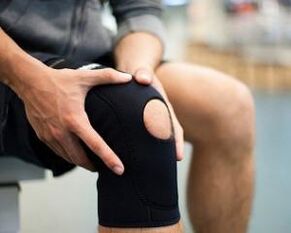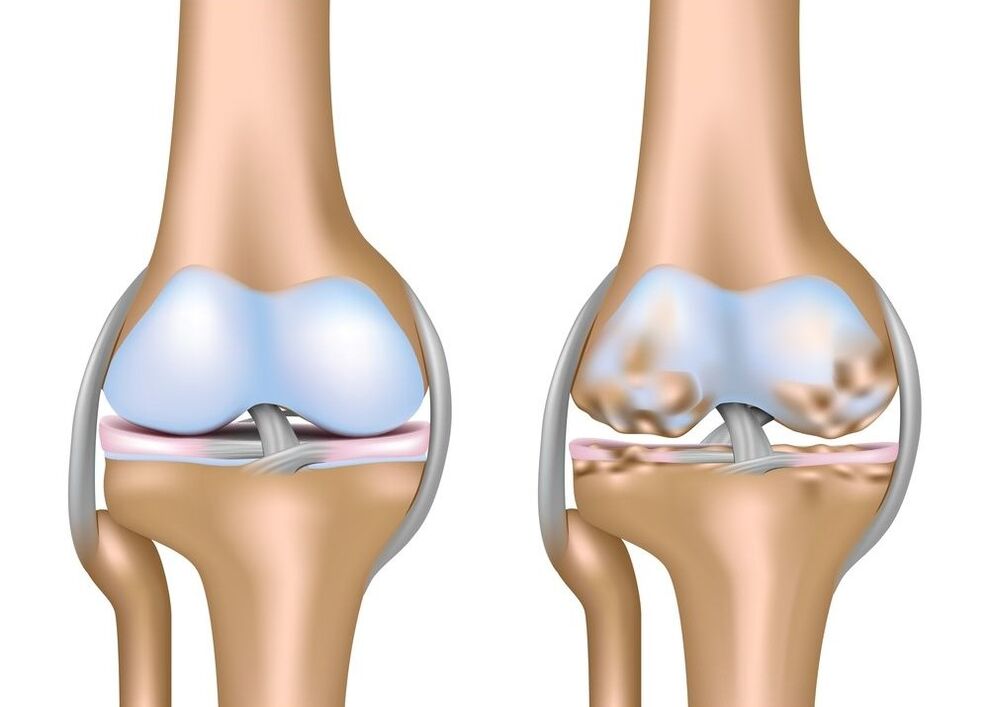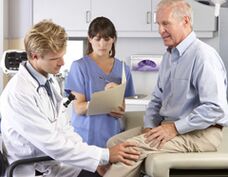Deformed arthritis of the knee joint is a multi-sex disease. This means that there are many reasons for its development. In some cases, when the most important cause can be assigned, the adrenitis is called secondary. The diagnosis of primary or idiopathic arthritis of the knee joint was established without identifying the obvious cause.

- Osteoarthritis deformation in the medial part of the femoral joint;
- Deformed osteoarthritis in the side of the femoral joint;
- Articulation and deformation of the graceful joints of the femur.
Usually, the destruction of articular cartilage occurs during the physiological withering of the entire organism, that is, during aging. When it occurs prematurely or at a more intense rate, pathological destruction of the cartilage is considered. On a completely legal basis, the average age of the first sign of cartilage degeneration itself is 40 to 50 years old. As the joints deformed, the disease debuted in childhood, initially manifesting itself as 16 to 18 years of age, and in some cases even earlier. But this is not the reason for despair.
The mechanism of the disease development is a vicious cycle in which ultimately contact initiates the initial contact, and so on. However, each round of the circle exacerbates the condition of the cartilage and leads to the progression of the disease, and so on. In the case of the main sixth symptom, the cause of the vicious cycle of firing is unknown. However, their subsequent links were carefully studied to influence them and slow the development of the disease.
The occurrence of deformed joints is approximately as follows. The daily articular cartilage of the knee joints undergoes thousands of shocks, and they are forced to depreciate to avoid damaging the body's gentler structures, such as internal organs and brain. Over time, due to data from concussion, microscopic cracks formed in the cloudy layer, which also filled with synovial fluid for a certain period of time and became a microdoctor. Adjacent micro-doctors have a tendency to unite and form larger cysts.
The increase in the size of the cyst in the corneal space gradually begins to squeeze blood capillaries, which feed on cartilage tissue from the side of the bone. It uses oxygen and the supply of substances required to maintain important activities, resulting in slower synthesis of type 2 collagen.
The transport of cartilage leads to two negative consequences. First, it leads to deterioration of depreciation characteristics and the formation of new microcracks more densely in the subsidiary layer. Second, due to the compression of the cartilage, its density increases, which adversely affects the second mechanism of its nutrition, namely the diffusion of the sliding fluid into the thickness of the cartilage tissue.
However, the damage to articular cartilage has not attracted attention on the scale of the organism. As a compensatory response to washing cartilage, chondrocyte activity - young cells synthesize new cartilage tissue. However, this compensation mechanism is imperfect, and its imperfection is that most of the cartilage tissue is not in the location where the cartilage is damaged, but rather that the cartilage is not under the load.

As a result, conical growth of cartilage forms along the edges of the joint-cartilage plant. These cartilage plants did not show clinically before the ossification process began. Okreteen, cartilage plants become hard and become, which is called ordinary people. Usually, the appearance of spikes is always accompanied by the occurrence of pain and the development of inflammation in the joints. This is due to the fact that during joint movement, bone plants touch the cartilage tissue and synovial shell, thus mechanically damaging it.
As a result, each complication of the deformed joint leads to accelerated progression of pathological changes in cartilage. However, understanding the mechanisms of gonadotropism can successfully influence some of its links to slow down its current rate and improve long-term predictions.
Secondary adenotropic cancer is different from the main cause known, which triggers a vicious cycle of articular cartilage destruction. The further process of the disease occurs in the same way as primary pro-arthritis, with the particularity that the disease continues to intensify due to the negative factors associated with the underlying disease. Therefore, the secondary arthropathy process of the knee joint is usually more aggressive.
- Injury (acute and chronic);
- Congenital variation or valgus deformation of the lower limbs;
- congenital shortening of one of the lower limbs;
- hypermotor syndrome in the knee joint;
- Congenital dysplasia of the knee joint;
- Cartilage calcification;
- Osteomyelitis;
- rheumatoid arthritis;
- acromegaly;
- diabetes;
- Obesity;
- Hypothyroidism;
- Fraud, etc.
Posttraumatic arthritis is divided into acute and chronic. The acute form of this disease occurs after a serious injury, more common -

, occurs or partially extends to the joint part of the bone. The chronic form of the disease takes place longer and is often associated with frequent and minor injuries to the joints. Such conditions are created by builders, road workers, porters, etc.
In acute lymph nodes, the mechanism of the disease is related to severe inflammatory changes in the joint cavity, i. e. , lymph node disorder, increased pressure in the joint cavity, and changes in the composition of synovial fluid. Excessive acceleration of new cartilage fabric growth can cause joint surfaces to deform in the fractured sites and in the growth of bone plants.
During chronic provocative processes, no severe inflammatory processes were observed, however, frequent and dense loads of cartilage tissues would lead to rapid compression, formation of microcracks and deterioration of cartilage supply, both from the lateral side of the bone and joint gaps).
People with this pathology often find it. Its essence is to change the shape of the legs. As the deformation deforms, the legs arch outwards on the horizontal plane. In other words, there is more space between the patient's legs than healthy people. As the valgus deforms, the legs have an X-shaped shape when the knees come into contact with each other. Due to fractures in the lower limbs, these two pathologies can be developed both through genetic programming and throughout life.
In both cases, the load on one side of the knee joint increases on the medial side, as the sides deform – as well as the lateral side. Because the patient's weight presses on a smaller area, premature cartilage occurs with inflammation, pain and morning stiffness.
Congenital shortening of one leg is an abnormal result or occurs several years after birth due to birth injury. As in the former case, the weight distribution is uneven and the normal legs bear a larger load. As a result, articular cartilage in healthy legs and knee joints undergoes structural changes, resulting in joint deformation.
This pathological condition is not a disease, but it is likely to cause it. This syndrome means excessive overmobility of ligaments and consistent devices, where joint movements of normal intra-axial joints can be significantly increased. Such patients almost never doubt that they have such a trait because they have lived on it all their lives and believe that others work in the same way.

The knee joint gives a sign of height that creates a stupid angle between the front surface of the thigh and the lower leg, with the legs straightening at maximum. In other words, the knees are always bent and the legs are very enthusiastic. Likewise, such patients can easily reach the forearm with their thumb, extend their head to the leg, and have in principle congenital flexibility.
Knee joint symptoms
In the initial stages of development, the pathology manifests as pain in the knee, moderately expressed and present during movement as it moves along the steps.
Unpleasant symptoms may occur if a person spends a lot of time standing or trying to sit down for a long time.
Health usually improves when resting.
Sharp and intense pain spontaneously occurs.
Most patients have previously felt discomfort while physically exercising and walking for a long time. In this case, increasing pain may be a major sign of the development of adenotropic cancer.
The disease gradually develops into months or years without visible deformation and severe pain. But during this period, knee discomfort occurs from time to time.
Remember that the sooner you consult your doctor, the treatment will pass.
Don't delay visiting experts and wait for irreversible consequences. Take measures immediately after noting the symptoms of the disease.
The obvious signs of articulation of the knee joint begin to manifest as the structure of the cartilage shell, reducing the production of sliding fluid and damage to the joint bag. Usually, there are usually no obvious symptoms in the initial stage of increased pathological changes, but at the same time there may be slight stiffness.
When pronunciation and various symptoms occur, arthritis is usually in the late stages of development. At present, the structure of the knee joint has been severely damaged, so the disease enters the acute phase. Characteristics of acute joint development include:
- Increase pain;
- Changes in gait;
- la way;
- Tighten when moving;
- Swelling of soft tissue;
- Increase knees as liquid accumulates in it;
- Limit joint mobility.

When knee arthritis occurs, the symptoms can last for a long time, but when the disease transitions to the last three stages of joint disease manifestation, the quality of life will greatly reduce the quality of life.
- In the context of the joint surface damage background, the synovium begins to inflame, which leads to violation of the mobility of the entire joint.
- Any movement with damaged joints can be very painful.
- During palpation, significant local body temperature was noted.
- Generally, it is possible to use conservative methods to effectively treat knee joints only in the early stages of disease development.
- Therefore, when signs of this disease occur, consult a doctor.
In the development of such a condition as the arthrosis of the knee, the symptoms and treatment are interconnected, since if at the early stages of the development of the disease the artistic surfaces can still be completely restored and improved by local metabolism, then in the later stages the drug treatment of arthrosis of the knee joint can often not have a positive effect, since cartilage tissues are so thin that bone structures are exposed.
Grade 1 arthritis has few obvious symptoms. The characteristics of this development stage are:
- Leg fatigue;
- Mobility decreased slightly, usually observed immediately after sleep.
The pain symptoms (if they occur) will show slightly. Currently, the articularity of the knee is seen in the form of small concave and concave on the surface of the bone in the form of X-rays.
With the joint nature of the secondary knee joint, the symptoms are more obvious. The pain has been generated from the minimum load or immediately afterwards. In the affected part of the legs, the pain is caused by almost any movement. After a considerable rest it usually passes completely. However, the next body movement immediately causes pain.
Around the second stage of the disease development, pain was added:
- Tightening in the knee joint during exercise;
- Reduces chances of normal knees and legs;
- Changes in joint bones;
- Progressive synovitis.
Often, rough joints are almost impossible to hear, but as the disease progresses, it becomes very loud and unique. When trying to bend the legs of your knees, severe pain occurs. In some cases, this can only be a 90-degree corner and then encounter difficulties and overcome pain. Changes in joint shape also become apparent, which is also exacerbated by the accumulation of pathological fluids.

The third degree arthritis is characterized by severe pain that is not related to the intensity of physical exercise. Even at night, joints can bother a person, which can cause great inconvenience.
X-rays can show global changes in cartilage, joint surfaces, and non-characteristic growth. The curvature of an O-shaped or X-shaped can lead to a person's disability. These are the consequences of the cartilage tissue having worn out, and the bone tissue goes into "move".
Adenotropic cancer is a disease of degenerative disease in which cartilage is damaged and joint deformation occurs. Signs of the disease are severe pain, deformation of the limbs, uneven distribution of load on the bone and muscle system, development of complications, and a significant reduction in the mobility of patients with disabilities.



















